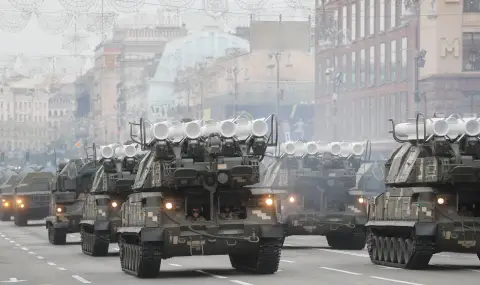Since the beginning of the full-scale war against Ukraine, Russia has used long-range missiles, to strike all over the country. Kiev is not yet able to respond symmetrically with missiles of its own production, and the missiles provided by Ukraine's partners are limited. Ukrainian President Volodymyr Zelensky recently announced the successful test of the first Ukrainian ballistic missile.
For now, drones remain Ukraine's primary means of striking targets deep inside Russian territory. But compared to missiles, they have less destructive power. To change the situation and reduce its dependence on missile supplies from its partners, Kiev is developing its own missile program.
"Palyanytsia" - a hybrid between a drone and a rocket
About the new Ukrainian weapon "Palyanytsia" President Zelensky said only that his first combat test was successful: "This is our new method of revenge on the aggressor. The enemy was defeated," he declared.
From the clarification made by the Minister of Strategic Industry of Ukraine Alexander Kamishin, it became clear that the hit enemy object was located on Ukrainian territory controlled by Russian units. "This is both a drone and a missile. "Palyanytsia" is designed and manufactured entirely in Ukraine, only some components are imported," he pointed out.
From a video posted on the United24 platform, it is also clear that this weapon was developed for a year and a half by Ukrainian specialists who "worked without a day off". "Palyanytsia" it has a turbojet engine, is launched from a ground platform and is equipped with several guidance systems. Its main purpose is to strike objects from which Russia is shelling Ukraine. More specifically, it concerns about 20 Russian airports. The most distant of them are "Savasleika" in the Nizhny Novgorod region and the main base of the Russian strategic aviation "Engels", located respectively 700 and 600 km from the state border.
As noted by United24, the cost of the drone missile is "much lower than its counterparts". In the absence of other data, at this stage it is impossible to assess how effective this Ukrainian weapon is. As the director of the information-consulting company "Defence Express" Sergey Zgurets, "much more important than the range of this weapon are its weight and warhead. It is they who determine the effectiveness", he assures. "Palyanytsia" not a completely new weapon that has no analogues in the world. The British Banshee Jet 80+, for example, is such a weapon that London has even already provided to Kiev.
Naval and land-based missiles "Neptune"
Other achievements of the Ukrainian missile program in recent years are the "Stugna" and "Corsair", produced serially, as well as the cruise missile R-360 "Neptune". The latter was adopted by the Ukrainian army in 2020 - together with the RK-360MC coastal missile system, designed to detect and strike enemy ships of various classes. The missile has a warhead weighing 150 kilograms and a range of up to 300 kilometers.
Neptun was used for the first time in combat conditions at the beginning of April 2022 against the Russian frigate "Admiral Essen". With two anti-ship missiles "Neptune" also in April 2022, the Russian cruiser "Moskva" was sunk. worth about 750 million dollars.
In 2023, it became known that Ukraine had managed to modify the "Neptune" to strike not only ships but also ground targets. The modified missile is equipped with a guidance system, has a range of about 400 km and a warhead of 350 kg - 200 kg more than the anti-ship version. The Ukrainian military has repeatedly used "Neptune" missiles. – for strikes on Russian anti-aircraft missile complexes, airports and oil terminals.
New developments
There are also reports that Ukraine has used modified missiles from the S-200 air defense system to strike ground targets on Russian territory. Ukraine also uses modernized Soviet reconnaissance drones Tu-141 "Strizh". This unmanned aircraft has a turbojet engine and can reach a speed of about a thousand kilometers per hour.
Back in 2023, President Zelensky stated that Ukraine had successfully used self-produced long-range weapons, and his advisor Mykhailo Podolyak added that there were "experimental samples" of missiles capable of hitting targets at a distance of 750-1000 kilometers. According to former Ukrainian Defense Minister Oleksiy Reznikov, work continues on a missile with an even greater range - over 1,000 kilometers.
The Ukrainian Ministry of Defense refused to provide information requested by DV about the country's missile program. From there, however, they specified that it is financed with funds from the state budget.
"Sapsan", "Coral" and "Korshun-2"
For the needs of its army in 2006, Ukraine developed the ballistic missile "Sapsan" with a range of 500 km, as well as an export version "Grum-2" with a range of 280 km. Also, a few years before the Russian invasion, Ukraine presented a prototype of the "Korshun-2" cruise missile based on the Soviet X-55.
Ukraine also has projects for anti-aircraft missile systems. In 2023, it was reported that two designs had successfully passed their first flight tests. According to the Minister of Strategic Industry, Oleksandr Kamishin, only the lack of funding is preventing Ukraine from speeding up missile production. However, military consultant Zgurets is convinced that Kiev's access to relevant technologies also plays a significant role. "Ukraine should use its partnership with leading American companies to improve its own developments," the expert emphasizes.
According to Frank Ledwidge, a former British military intelligence officer and expert at the University of Portsmouth, Ukraine is already capable of producing enough missiles to go to war with Russia. This means that Kiev produces several hundred ballistic and cruise missiles each year, the experts specify.
Author: Alexander Kunitsky
